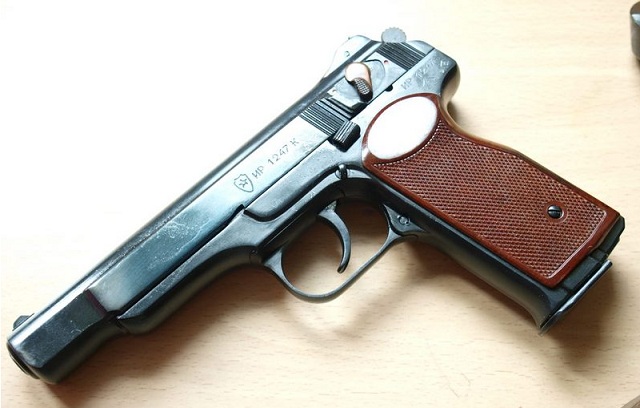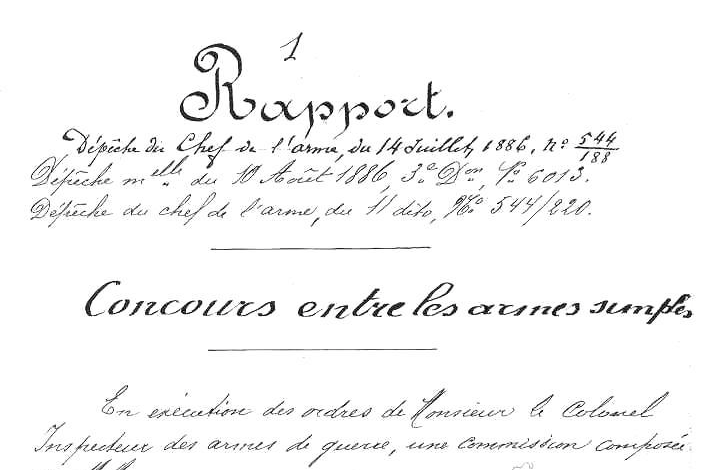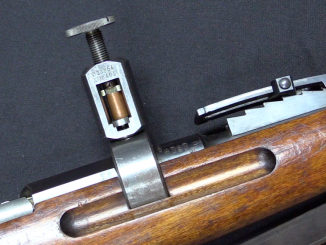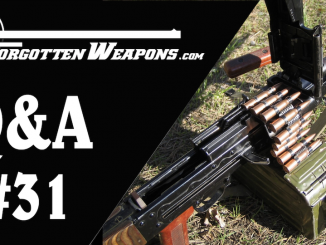The Stechkin automatic pistol was adopted by the Soviet military in 1951, alongside the Makarov pistol. Both are chambered bot the 9x18mm Russian cartridge, and both use simple blowback mechanisms. The Stechkin is a heavier and bulkier pistol, though, as it is designed for fully automatic fire.

The Stechkin uses a 20-round magazine as standard, and has a selector switch allowing single shots or automatic. It was originally issued with a combination shoulder stock/holster (much like the Mauser 1896) to allow more precise shooting, and was supplied to support troops like tankers, RPG carriers, and artillerymen. It became apparent, however, that a machine pistol was not a particularly practical weapon, and the Stechkin was slowly withdrawn from use. The weapon received a bit of new life in the 70s, when some existing stocks were updated for Spetsnaz use, with the addition of sire stocks, threaded barrels, and sound suppressors.
Over in the Vault page on the Stechkin we have a copy of a Russian manual on the piece from 1960, as well as a US government official translation of it into English, for folks who would like more details.




Big fan of your YouTube channel!
I am curious if you have any videos explaining the history and function of the Stechkin?
Thank you and good luck in the future!
Mark
Good Afternoon.
The Russian embassy GRU folks used the 7.62 X 25MM
(Tokarev cartridge)
silenced Stechkin pistols in the very early 1960’s..
Fun-N-Games.. 1/2 century ago..
Not in 7.62Tok they didn’t! They might have had unsilenced TT33s in 7.62Tok [’cause why put a silencer on a very supersonic pistol round?] or they used Stechkins in its native 9mmMak chambering. As Ian points out here, the Stechkin is blowback, and the 7.62Tok requires a locked-breech action in something the size of a pistol.
Good morning.
The cartridges might have been a sub-sonic load.
However, the empty brass was 7.62 Tokarev.
and the bullets contained hardened steel pins.
The medic identified the pistol as “7mm Stechkin”.
Embassy people did not carry 9mm as those were
considered to be ‘military’ weapons..
Same as civilian police in European countries
carried .30 or .32 / 7.XX mm caliber pistols..
Many full-auto pistols forgo the locking mechanism
and just use a stronger recoil spring..
As for silencing supersonic cartridges,
they make ‘suppressors’ for rifles firing the .50 BMG round.
Your post shows you have no idea what you’re talking about.
Surculus is 100% correct. You are right that .50 BMG suppressors exist.
GRU is the main Russian military intelligence directorate. They absolutely use military weapons/calibers. Why would they not, when guarding their own embassy?
Good Morning Mr Crowe.
This particular GRU was not ‘defending his embassy’
but was watching a KGB agent.
I believe that it was in some response to WW1 which limited “police and civilian” weapons to less than 9mm.
The Stechkin in 7.62mm was considered a “non-military” weapon, for that reason. Since he was carrying this weapon on the streets of Washington, D.C., it was not appropriate for him to be carrying a “military” weapon..
I have no idea of what other weapons were available at the embassy itself.
Today, I believe that the “less than 9mm” has totally been superseded by “whatever works best”.
A while back, on some bulletin board, a Russian policeman sang the praises of the Stechkin as a solid, high capacity side arm. Leaving the full-auto matter to the side. At least some had been taken out of storage and issued as pistols.
The first Stechkin pistols were chambered in 7.62 x 25 mm Tokarev.
These pistols were issued to GRU officers at Russian embassies
in America, and probably other countries as well. The 9mm was considered to be a “military” cartridge, the 30 cal to be “civilian”.
They were equipped with a very efficient silencer, which had a flaw.
Under side pressure, the silencer could deflect enough for the
copper jacketed armor-piercing bullets to contact the baffles.
The silenced 7.62 mm Stechkin machine pistols were definitely in use
at the Russian embassy in Washington, D.C. in 1961.
Not 1960’s but:
https://military-history.fandom.com/wiki/OTs-38_Stechkin_silent_revolver
The OTs-38 Stechkin is a 5-shot, double-action revolver, in production and service with the Russian Army since 2002, chambered in the silent 7.62x42mm SP-4 cartridge
Then from Ian’s web site:
https://www.forgottenweapons.com/russian-silent-ammunition/
he SP-1 cartridge never went past prototype stage, but within several years Stechkin designed his next internally silenced cartridge, known as SP-2. This one also contained a small powder charge behind the piston, but this time powder gases were to be captured inside the bottlenecked cartridge case, which looked somewhat similar to that of the 7.62×39 M43 round. Since the pusher piston was relatively short, and before discharge seated deep in the cartridge case, the bullet had to be made long, but relatively light. To achieve this, Stechkin used metal jacket taken from an unassembled 7.62mm pistol (7.62×25) bullet and fitted it with aluminum core that extended back from the jacket to rest on the piston.
http://www.smallarmsoftheworld.com/display.article.cfm?idarticles=481
The SP-1 cartridge never went past the prototype stage, but within several years Stechkin designed his next internally silenced cartridge, known as SP-2. This one also contained a small powder charge behind the piston, but this time powder gases were to be captured inside the bottlenecked cartridge case, which looked somewhat similar to that of the 7.62×39 M43 round. Since the pusher piston was relatively short, and before discharge seated deep in the cartridge case, the bullet had to be made long, but relatively light. To achieve this, Stechkin used a metal jacket taken from an unassembled 7.62mm pistol (7.62×25) bullet and fitted it with an aluminum core that extended back from the jacket to rest on the piston.
This round apparently was produced in very limited numbers and used in some ‘Q-style’ weapons, such as the three-shot pistol disguised as a tin cigarette container. Also, it was probably used in the earliest model of the more convenient-looking two-barrel derringer-type pistol, which served as a predecessor to the MSP pistol described below.
I carried a Stechkin on my first two contracts in Iraq back in 04’. Awesome pistol. Never bothered with the shoulder stock but used a Eagle Industries thigh holster for an HK Tactical which fit the APS perfectly. Disregard all that gunwriter BS there is no place for machine pistols, the Steckhin was awesome at normal pistol ranges and highly controllable. I’ve carried the 1911A1, M-9, and P-35 in warzones and the APS was my hands down favorite weapon. It was also extremely well made and very accurate.
PS-FWIW I got an API 250 “Expert” diploma from Gunsite back in 1988 so I have a passing familiarity with the handgun………
Good Morning Tyler.
Thanks for your experience..
My experience with a 7.62 Stechkin
was in the “early 1960’s”..
The medic who picked lead and copper
out of my legs identified the
pistol as a “7mm Stechkin”..
I still retain the scars..
As I am informed, the 7.62mm was a ‘prototype’
which was used in “foreign countries”
because of the WWII ban on “9MM” cartridges
for “civilian” uses.. EG: embassies..
Merry Christmas!!
Eric.